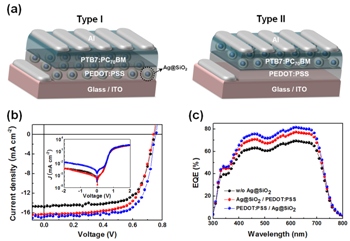May 8 2013
Researchers from Ulsan National Institute of Science and Technology (UNIST) demonstrated high-performance polymer solar cells (PSCs) with power conversion efficiency (PCE) of 8.92% which is the highest values reported to date for plasmonic PSCs using metal nanoparticles (NPs).
 (a) Device structures, (b) J−V characteristics, and (c) EQE of PTB7:PC70BM-based PSCs with type I and type II architectures
(a) Device structures, (b) J−V characteristics, and (c) EQE of PTB7:PC70BM-based PSCs with type I and type II architectures
A polymer solar cell is a type of thin film solar cells made with polymers that produce electricity from sunlight by the photovoltaic effect. Most current commercial solar cells are made from a highly purified silicon crystal. The high cost of these silicon solar cells and their complex production process has generated interest in developing alternative photovoltaic technologies.
Compared to silicon-based devices, PSCs are lightweight (which is important for small autonomous sensors), solution processability (potentially disposable), inexpensive to fabricate (sometimes using printed electronics), flexible, and customizable on the molecular level, and they have lower potential for negative environmental impact. Polymer solar cells have attracted a lot of interest due to these many advantages.
Although these many advantages, PSCs currently suffer from a lack of enough efficiency for large scale applications and stability problems but their promise of extremely cheap production and eventually high efficiency values has led them to be one of the most popular fields in solar cell research.
To maximize PCE, light absorption in the active layer has to be increased using thick bulk heterojunction (BHJ) films. However, the thickness of the active layer is limited by the low carrier mobilities of BHJ materials. Therefore, it is necessary to find the ways to minimize the thickness of BHJ films while maximizing the light absorption capability in the active layer.
The research team employed the surface plasmon resonance (SPR) effect via multi-positional silica-coated silver NPs (Ag@SiO2) to increase light absorption. The silica shell in Ag@SiO2 preserves the SPR effect of the Ag NPs by preventing oxidation of the Ag core under ambient conditions and also eliminates the concern about exciton quenching by avoiding direct contact between Ag cores and the active layer. The multi-positional property refers to the ability of Ag@SiO2 NPs to be introduced at both ITO/PEDOT:PSS (type I) and PEDOT:PSS/active layer (type II) interfaces in polymer: fullerene-based BHJ PSCs due to the silica shells.
Because PSCs have many advantages, including low cost, solution processability, and mechanical flexibility, PSCs can be adopted in various applications. However, we should break the efficiency barrier of 10% for commercialization of PSCs.
Jin Young Kim and Soojin Park, both, Associate Professors of the Interdisciplinary School of Green Energy, Ulsan National Institute of Science and Technology (UNIST), Ulsan, South Korea, led this work.
Prof. Kim said, “This is the first report introducing metal NPs between the hole transport layer and active layer for enhancing device performance. The multipositional and solutions-processable properties of our surface plasmon resonance (SPR) materials offer the possibility to use multiple plasmonic effects by introducing various metal nanoparticles into different spatial location for high-performance optoelectronic device via mass production techniques.”
“Our work is meaningful to develop novel metal nanoparticles and almost reach 10% efficiency by using these materials. If we continuously focus on optimizing this work, commercialization of PSCs will be a realization but not dream,” added Prof. Park.
This research was supported by WCU (World Class University) program through the Korea Science and Engineering Foundation funded the Ministry of Education, Science and Technology (Minister Lee Ju-Ho) and the National Research Foundation of Korea (President Seung Jong Lee). It has published in Nano Letters (Title: Multipositional Silica-Coated Silver Nanoparticles for High-Performance Polymer Solar Cells ).